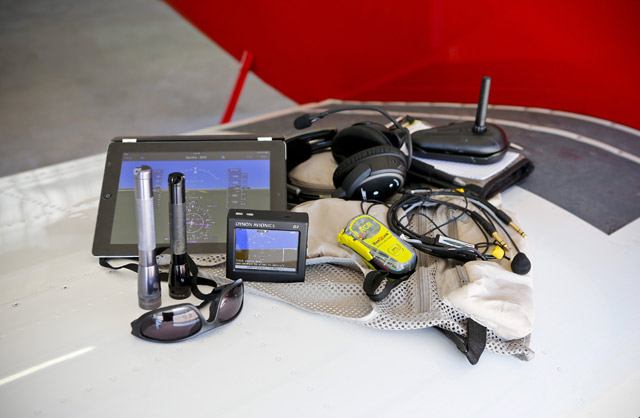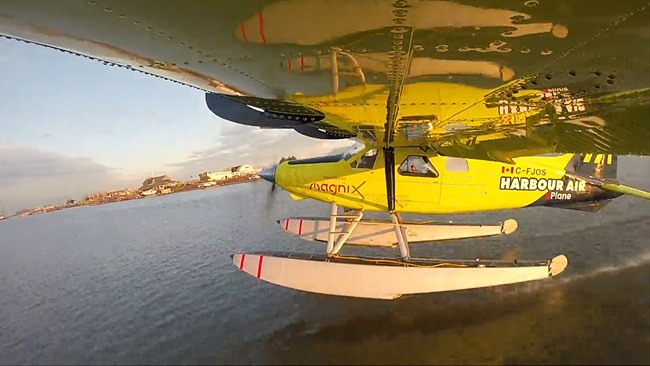My dozen ‘essentials’

Flying light VFR aircraft on long trips requires reducing the contents of your flight bag to the absolute minimum. There simply isn’t room for excess stuff.
During ferry flights this year in airplanes such as an American Champion Citabria, Piper J–3 Cub, Pitts S–1, and the Reimagined Cessna 152, I’ve gone from Alaska to Arizona and Wyoming to Maine—and brutally pared the contents of my flight bag. Here are my 12 travel “essentials.”
An Oregon Aero seat cushion. It’s expensive ($173) but worth it, especially for marathon trips. I feel silly toting the memory-foam “child seat” through TSA inspections, but the state of a pilot’s backside profoundly affects his or her state of mind. And simply being comfortable and free from back pain greatly enhances one’s enjoyment of flying.
An ADS-B receiver. They all have pluses and minuses, but my Garmin GDL 39 has become a trusted friend. In-cockpit weather is the greatest safety feature VFR pilots have ever been granted. And the $100 accessory battery pack can power the receiver for four hours at a stretch. When a cigarette lighter adaptor isn’t available (or fails), that battery pack is worth its weight in gold. (And the attitude and heading reference system that provides synthetic vision via Bluetooth is good peace of mind.)
iPad. The darn thing is indispensable. I resisted for the first year or so, but now I can scarcely imagine making a long ferry trip without it.
Personal locator beacon. I carry an ACR model, but there are many fine offerings in this area. I’m also intrigued by the new generation of satellite phones/messengers (especially the DeLorme inReach and Iridium GO!) but haven’t sprung for one yet.
Noise-canceling headset. Loud cockpits can be tremendously fatiguing, and reducing the noise level can vastly enhance mental acuity by the end of a long flight. Bose generously sponsored the AOPA 2015 Sweepstakes Reimagined Cessna 152 by providing A20 headsets for the winner. I started wearing the Bose while making a technique video in the airplane, and now I want to bring it with me wherever I go.
Halo in-ear headset. This unit is incredibly small and light, and it’s easy to take along—although I usually carry it as a spare. When I bring a companion, I let the passenger use the noise-canceling headset while I wear the Halo.
Afrin. Especially in the spring, a preflight shot clears the sinuses and keeps them open all day long.
Sunglasses. I prefer Flying Eyes because they fit well with a noise-canceling headset.
Flashlight. Actually, two of them, both using the same double-A batteries as my headset—so I only have to stock up on one kind of battery.
Kneeboard. I bought my trifold model from Sporty’s more than 20 years ago, and it’s held up remarkably well. Now, it’s as much a good-luck charm/comfort blanket as a notepad.
Portable GPS. There are lots of good ones out there, but for size, readability, battery life, and push-button data entry, it’s tough to beat a Garmin GPSMAP 496. I don’t use the XM Weather feature anymore, so the battery lasts longer. And I’m embarrassed to say the aviation data is years out of date. But ADS-B provides subscription-free weather, and the charts in the iPad are current.
Dynon D2 Pocket Panel. This all-in-one, stand-alone electronic flight instrument system can be a lifesaver, especially in no-gyro airplanes. It clips into, or onto, any instrument panel, and it provides immediate and reliable groundspeed, ground track, and attitude information. When flying at night, in hazy conditions, or with a less-than-perfect vacuum system (and let’s face it—they’re all less than perfect), I’ve come to rely on this trusty little marvel.
Email [email protected]
Frugal Flier coverage sponsored by Aircraft Spruce



